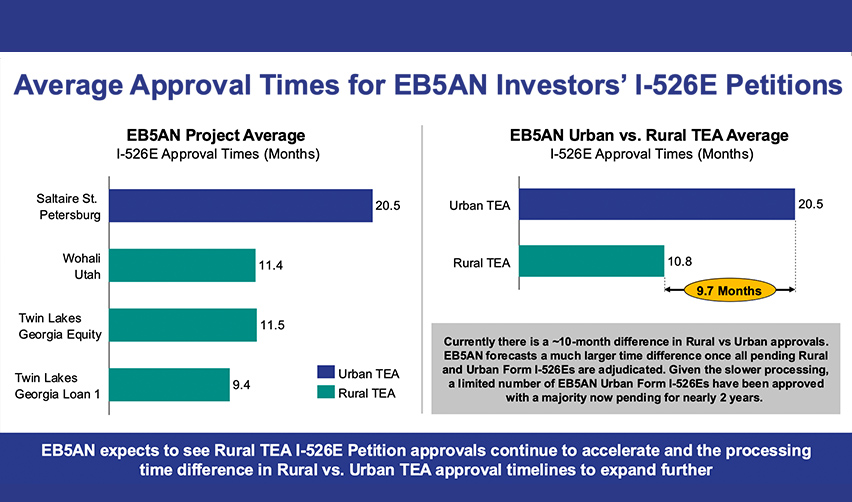One of the primary reasons foreign nationals choose the EB-5 program over other immigration options is the opportunity to receive U.S. Green Cards in a matter of months. For much of the EB-5 program’s history, processing times were uncertain and often took multiple years—especially for investors from high-demand countries such as China and India.
But under the EB-5 Reform and Integrity Act of 2022 (the RIA), EB-5 investors in rural projects qualify for priority processing of their USCIS petitions. As a result, the new standard is for EB-5 investors in rural EB-5 projects to receive Form I-526E approvals in approximately 12 months or less.
Investors in urban EB-5 projects do not qualify for priority processing.
Given the choice between rural and urban projects, foreign nationals who are planning their EB-5 investments should answer this key question: “How much faster are I-526E approval times for investors in rural projects than the approval times for investors in urban projects?”
On average, investors in rural projects are receiving I-526E approvals in approximately half the time as investors in urban projects. This conclusion is based on recent processing data from EB5AN’s urban and rural EB-5 projects.
In this post, we review the processing data for rural and urban EB5AN projects. The data show that rural EB-5 projects are a significantly faster path to U.S. Green Cards—especially for Chinese and Indian EB-5 investors.
New Immigration Benefits for Investors in Rural EB-5 Projects
Rural and Urban I-526E Processing Data: How Much Faster is Rural?
Consider the Benefits of Investing in a Rural EB-5 Project
New Immigration Benefits for Investors in Rural EB-5 Projects
Under the RIA, EB-5 investors in rural projects qualify for priority processing—regardless of their nationality.
When the RIA was signed into law in March 2022, it was unclear to what extent priority processing would impact the I-526E approval times for investors in rural projects. (EB-5 investors generally receive their U.S. Green Cards shortly after I-526E approval.) As mentioned above, investors in rural projects are now receiving I-526E approvals in 12 months or less.
In addition, the RIA created new categories of set-aside visas for both rural and urban projects. By qualifying for a set-aside visa, EB-5 investors from countries with a backlog of EB-5 applications can avoid processing delays—which can take several months or even years.
Both Chinese and Indian investors can avoid long delays through the set-aside visa categories.
There is a limited number of visas in each set-aside category. The rural category receives 20% of the annual EB-5 visa supply; the urban category receives 10%.
Even though the supply of urban visas is significantly lower, both the rural and urban categories remain current as of the September 2024 Visa Bulletin. But as we will see below, the urban set-aside visa supply is at risk of becoming exhausted in the near future.
Rural and Urban I-526E Processing Data: How Much Faster is Rural?
With multiple I-526E approvals under the RIA, we now have a reliable body of data for both rural and urban projects that allows us to compare processing times for both project categories.
Consider the following processing data from our Saltaire St. Petersburg urban project and our Wohali Utah, Twin Lakes Georgia Equity and Twin Lakes Georgia Loan (Phase 1) rural projects.
The three rural projects had average I-526E approval times of 11.4 months, 11.5 months, and 9.4 months, respectively.
This means that the rural project category had an average I-526E approval time of only 10.8 months. In contrast, the Saltaire urban project had an average approval time of 20.5 months—nearly two years.
Notice that the average approval time for our rural projects is 9.7 months shorter than the 20.5 months for the Saltaire urban project.
Based on this data, we can expect investors in rural EB-5 projects to receive I-526E approvals in approximately half the time as investors in urban projects. In other words, investing in an urban project could mean an additional wait time of about 9.7 months—or significantly more.
The fastest I-526E approval in this dataset was 8.3 months for an investor in the Twin Lakes Loan (Phase 1) rural project. The slowest approval time was 21.2 months for an investor in the Saltaire urban project. In this case, the Twin Lakes investor received his I-526E approval 12.9 months faster than the Saltaire investor.
EB-5 investors who want to receive U.S. Green Cards as quickly as possible should consider investing in a rural project instead of an urban project.
In a matter of months—not years—investors in rural projects could be holding their physical U.S. Green Cards and living in the United States as conditional permanent residents.
In fact, multiple investors in EB5AN’s rural projects already hold their physical U.S. Green Cards.
For example, two Chinese nationals received their U.S. Green Cards in 10 and 14 months, respectively. An Indian national received his Green Card in 16 months.
Even though the current data shows that investors in urban projects may have to wait twice as long for I-526E approval, the actual wait times for urban projects are likely to become longer in the future because of a visa backlog.
Consider the Benefits of Investing in a Rural EB-5 Project
If you and your family are interested in obtaining U.S. Green Cards quickly, your safest option is to invest in a rural EB-5 project.
“With an ample supply of set-aside visas and priority processing, rural projects offer a fast, low-risk path to U.S. Green Cards,” explains EB5AN managing partner Sam Silverman. “When deciding whether to invest in an urban or rural project, EB-5 investors of any nationality should consider the fast I-526E approval times for rural projects.”
“Chinese and Indian investors”, Silverman concludes, “should take seriously the USCIS data showing an upcoming backlog for the urban set-aside visa category.”
To learn more about qualifying for U.S. Green Cards through a rural EB-5 project, schedule a free consultation with schedule a free consultation with EB5AN.








